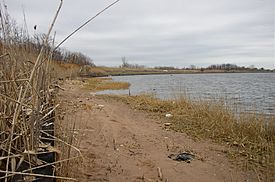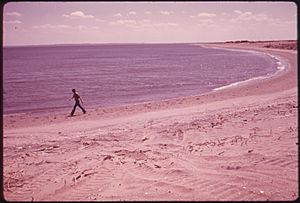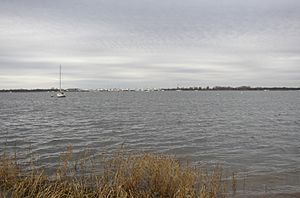Great Kills Park facts for kids
Quick facts for kids Great Kills Park |
|
|---|---|
 |
|
| Type | Urban park |
| Location | Staten Island, New York City, New York, United States |
| Area | 580 acres (230 ha) |
| Created | 1949 |
| Operated by | National Park Service |
| Status | Open all year. Part of park is closed for decontamination. |
Great Kills Park is a large public park located in Great Kills, Staten Island, New York City. It was originally known as Marine Park. This park is part of the Staten Island section of the Gateway National Recreation Area. The National Park Service takes care of it.
The park covers about 580 acres (235 hectares). It includes different natural areas like salt marshes, beaches, and woodlands. It stretches for about two miles (3 km) along the south shore of Staten Island.
Contents
Getting to Great Kills Park
The main entrance to Great Kills Park is at Hylan Boulevard and Buffalo Street. You can catch the S78, S79 SBS buses right there. The Bay Terrace station for the Staten Island Railway is also very close to the main entrance. If you have a boat, you can get into the park through Nichols Marina in Great Kills Harbor.
History of the Park
Early Days and Crooke's Point
In 1860, a businessman and nature lover named John J. Crooke bought some of the land. He lived in a wooden house right on the beach. Over time, the land changed. In 1916, strong waves caused erosion, which means the land wore away. This made Crooke's Point become its own small island.
Planning a Public Park
As early as 1925, the New York City government started thinking about buying land for a public playground. They first considered buying 50 acres (20 hectares) from Crooke. Mayor John Francis Hylan then thought about buying even more land, up to 443 acres (179 hectares). The idea was to make a much bigger park, possibly growing to 1,000 acres (405 hectares) later. They even planned to build a resort there, which was expected to cost $10 million.
Building the Park and New Features
In 1929, the city bought Crooke's Point and the land next to it. They began building the public park. However, work was slowed down by the Great Depression and World War II. Because of these delays, the park didn't open to the public until 1949.
From 1926 to 1941, an incinerator operated at the park site. This machine burned trash. Unfortunately, over 197,000 tons of toxic waste from the incinerator remained at the site.
In 1933, a special event happened at the park: a pioneering rocket launch! Because of this, the American Institute of Aeronautics and Astronautics has marked the location as a "Historic Aerospace Site."
Great Kills Harbor, which is inside the park, was created in the 1940s. Workers expanded the area and reconnected Crooke's Island to Staten Island. They used landfill and material from dredging (digging up the bottom of the water).
Becoming Part of Gateway National Recreation Area
Many different kinds of birds visit the park's varied habitats. In 1973, Great Kills Park became part of the Gateway National Recreation Area. Other places that joined at the same time included Miller Field and Fort Wadsworth on Staten Island, Jamaica Bay in Brooklyn and Queens, and Sandy Hook in New Jersey. Today, the park has the Nichols Marina, a beach, walking trails, places for fishing and bird-watching, and sports fields.
Park Cleanup and Safety

The park was built using about 15 million cubic yards of landfill material from the 1940s. This material included regular trash and medical waste. In 2005, a substance called radium (specifically 226Ra) was found in the sand. Radium is a radioactive material. At the spots where it was found, investigators measured gamma radiation that was about 200 times higher than normal background levels.
Because of this, almost half of the park has been closed to the public since 2009. The National Park Service is working on a big cleanup project. They expect to finish a detailed study in 2020 to plan for the long-term cleanup of the park.
Images for kids




